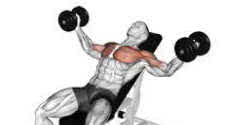Dumbbell Flys Exercise: Advice on Form & Weight for Chest Development

Don't get stuck with no results in the gym due to lack of knowledge
Dumbbell flys are almost always considered a defining, not mass-building, exercise; and in observing the
manner in which most bodybuilders perform them, I can see why. How can flys possibly build mass when
they're done with light weight, high reps and too much of a stretch in the extension part of the movement?
Some of my best chest development came from dumbbell flys, but only when I did them with mass in mind.
That meant I had to ignore that revered "stretch" everyone says you must get at the bottom of this movement
and go, instead, for pectoral contraction.
After all, contraction - forcing the pecs together under extreme resistance - is the way to make your
chest grow; stretching only subjects it to injury. The mass-building action is therefore in the top
three-fourths of the fly movement; the bottom fourth does not build and is only a danger zone.
Once again, the mass principle holds: maximum poundage for low reps. Your pectoralis major is a bulky, thick
muscle area, and high repetitions only enervate it; they don't hypertrophy it.
After a few warm-ups, I do five or six sets to absolute failure, pyramiding upward in weight while reducing
reps from 15-20 on the first set to four or six on the last. These heavy sets virtually restrict the movement
to the effective upper-three-fourths zone. That's where I really dig into the weight. At the top, I straighten
my arms and touch the dumbbells together.
To beef up my pec-delt tie-ins and the upper pec area, I use an incline bench. When I want to concentrate
on the inner and lower pecs. I switch to a flat bench.
It all comes down to keeping your training principles simple and traditional if you're after mass. Don't be
afraid to work long, hard and heavy. And, remember to believe in over-training is to surrender.